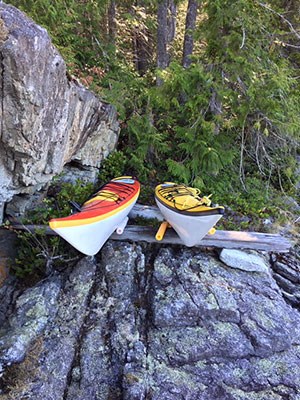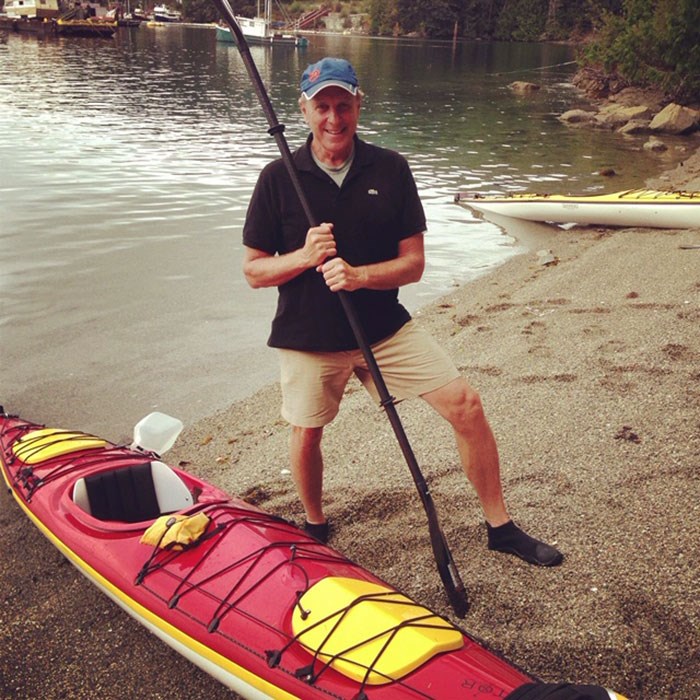It all started in 1978 when we decided to fly to Haida Gwaii and borrow our friends’ kayaks for trip into Gwaii Haanas (then known as the South Moresby wilderness area).
We were just married and finishing grad school, with plans to move to Alberta in the fall.
Our pals in Queen Charlotte City offered to lend us their gear, along with annotated charts and the local travel lore they had accumulated in several prior trips “down south.”
We had worked as outdoor educators for several summers at Strathcona Park Lodge and Outdoor Education Centre on Vancouver Island, and knew about trip planning, southeasters, making big inlet crossings (go early!), the importance of tide books and pitching double tent rain flies even in August.
It’s now 41 years since we first kayaked to the old Haida villages of Cumshewah, Skedans, Hl’kia and Tanu, on a two-week paddle where we saw no one else after pushing off from the Sandspit beach.
In the past four decades, we’ve kayaked two more times in Gwaii Haanas, travelled to the Bunsby Islands from Kyuquot, explored Nuchatlitz and the south end of Nootka Island, and made numerous trips up and down the Sunshine Coast.
Many of our trips were made with good friends, but an equal number were made simply as a couple.
We have evolved our kayak trip skills to the point where we have very defined tasks on the water and on the beach.

I’m in charge of tent pitching, sleeping bags, water proofing, wood hauling and splitting, water hauling, dish washing and fishing gear. My wife is in charge of all aspects of food collection, packing, kitchen shelter setup, meal preparation and leftover storage. She’s usually our fisher and has famously landed a coho in a kayak.
Together, we wash clothes (if we can find fresh water), write and make art, find and explore archaeological sites, take ocean swims and pick berries.
We both also keep a weather eye open, and watch for black bears and Norwegian rats. I once had to unzip the tent door, after we had gone to bed on Kunga Island, to allow a very large rat to escape from the bottom of our sleeping bags.
Principally, we still practise exactly the same task allocations. But some things have changed over the past four decades.
We are, for example, refining some of our gear. Once we both got jobs, we were able to buy our own kayaks (beautiful and B.C.-made by Seaward Kayaks). We also evolved their carriage to the point where we use a Thule aluminum kayak truck rack and have a pickup to whisk them to the head of most inlets we travel down to the open ocean.
In terms of essential trip gear, we’ve also made some key refinements. For instance, this year I finally put my head to hand-line design. For four decades I’ve wound 20-pound test monofilament around a bit of drift wood, tied a lure to the end and given it to my wife to catch dinner.

Two years ago, a beautiful coho snapped the old line at kayak side in Nuchatlitz lagoon after a 15-minute heroic effort by the fisher. It was not a happy moment. Chastened, I’ve just returned from the Powell River Marine Traders, where I bought a black plastic cleat, eight pulls of 100-pound test halibut line, a stainless steel swivel, and a shiny plug lure with a treble hook.
The new rig drew attention from the good old boys in the store when I laid it on the counter.
“Sure looks like a killer!” said one with a smile.
Another recent first-time purchase is a waterproof, hand-held, battery-charged radio phone. Unbelievably (especially to our daughter, who cautions us not to overdo it as we continue backcountry travel into our late 60s), we’ve never had one before. We simply told friends where we were going and when we were coming back.
It’s hard to think that we aren’t as spry as we once were. But I guess we aren’t. We’re even carrying pills that have to be taken every day on our upcoming trip to the Broken Group Islands.
Nevertheless, the thrill of a new trip, to a new locale, is still motivating us. Onwards.
Troy Media columnist Mike Robinson has been CEO of three Canadian NGOs: the Arctic Institute of North America, the Glenbow Museum and the Bill Reid Gallery.



